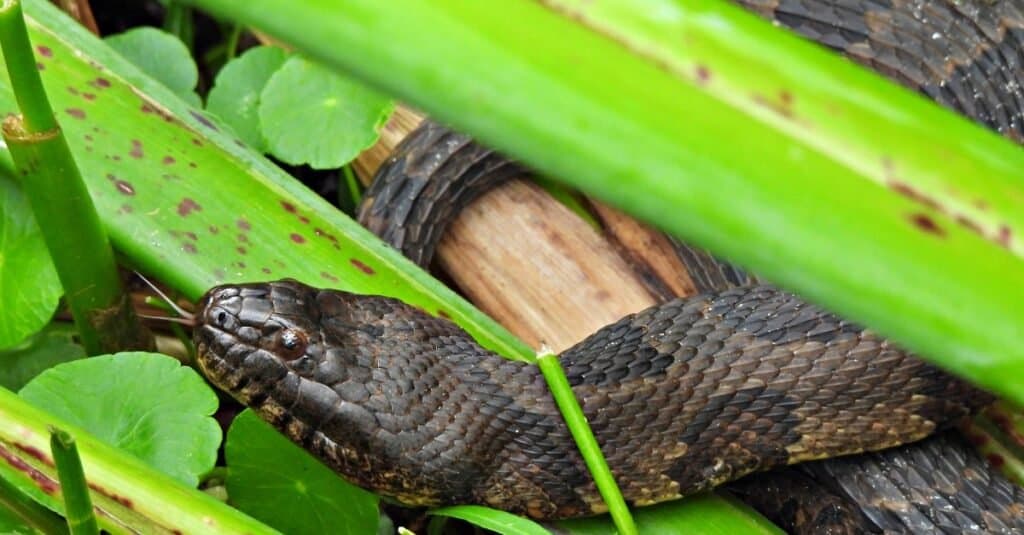Key Facts
- Green water snakes (Nerodia Cyclopion) are among the most common snakes found in Mississippi and in Alabama, Kentucky, and Louisiana.
- Mississippi green water snakes often live in cypress swamps and the Mississippi lowlands.
- These semi-aquatic reptiles normally grow between 30 – 45 inches.

Mississippi is home to over 48 reptile species including water snakes.
©iStock.com/ianpjones
Mississippi is the 32nd largest and 35th most populous state in the United States, with the Mississippi River defining its western borders. The state’s name is a Native American term that means “great water” or “father of waters.” It is easy to find forests, marshes, coastal dunes, and other types of scenery across the state. Given this, it is not surprising that the state is home to more than 500 types of wildlife, including over 48 reptile species, both venomous and non-venomous.
One of the most well-known reptile species is the green water snake (Nerodia Cyclopion), a common species of non-venomous snake endemic to the southeastern parts of the United States, particularly Alabama, Mississippi, parts of Kentucky, and Louisiana. Keep reading to discover the largest Mississippi green water snake ever recorded.
How To Identify A Mississippi Green Water Snake

Mississippi green water snakes have large heads and scales on their upper lip.
©Ryan M. Bolton/Shutterstock.com
The Mississippi green water snake is a non-venomous snake species belonging to the family Colubridae, genus Nerodia, order Squamata, and suborder Serpentes. The green water snake has a medium-sized, thick body and a dark color, and it is also semi-aquatic. Most of these snakes are dark green or olive in color with numerous sparse, faint olive-brown or dark brown patterns that alternate down the back and flanks.
They have large heads and scales on their upper lip and between their eyes, which helps set them apart from other water snakes. Green water snakes also have keeled dorsal scales in rows 27 to 29 towards the center of their bodies. They also have small scattered olive-brown or dark-brown markings on their sometimes greenish-brown backs. Another way to tell them apart from other water snakes is that there are also several yellow half-moon-shaped marks on their bellies.
What Is The Largest Mississippi Green Water Snake Ever Recorded?

As established, Mississippi green water snakes are medium-sized snakes. Most adult green water snakes grow as long as 30 to 45 inches (76 to 114 cm) in total length, tail inclusive. The largest Mississippi green water snake ever recorded was 51 inches (129 cm) long.
What Do Mississippi Green Water Snakes Eat?
Generally, water snakes are primarily carnivorous, preying on smaller creatures around their habitat. Mississippi green water snakes are carnivorous nighttime hunters that prefer to hunt alone. Because they are non-venomous and are not constrictors, green water snakes eat their prey whole while they are still alive. Amphibians living in or near water make up most of their diet, particularly salamanders, frogs, toads, and other freshwater amphibians. They also feed on smaller water creatures like minnows, crayfish, and other smaller fish, dead or alive. Green water snakes are semi-aquatic animals, meaning they also spend time on land and eat other small rodents and reptiles.
Like most water snakes, Mississippi green water snakes are preyed on by larger snakes, birds, raccoons, foxes, and sometimes skunks. Because they are non-venomous, fighting off predators might be a little difficult. Because of this, Mississippi green water snakes frequently swim across bodies of water to avoid predators or dive below the water’s surface to anchor themselves to logs or vegetation. They usually wait a few minutes underwater till the threat has passed but can remain submerged for at least an hour.
Where Can Mississippi Green Water Snakes Be Found?

The Mississippi green water snake resides primarily in cypress swamps and the river slough of the Mississippi lowlands.
©iStock.com/Shoemcfly
Mississippi green water snakes are primarily swamp-dwelling snakes, residing primarily in cypress swamps and the river slough of the Mississippi lowlands. Mississippi green water snakes can be found from southern Illinois through the Mississippi Valley to the Gulf of Mexico. Additionally, they can be found in coastal regions stretching eastward to the far western Florida panhandle and westward into Texas. They are only present in Mobile and Baldwin Counties in Alabama. However, they are occasionally discovered in brackish waters along the Gulf Coast.
Lakes, ponds, swamps, marshes, and bayous are among the tranquil waters Mississippi green water snakes enjoy. Essentially, they prefer the calm, leisurely waters of cypress swamps, slough streams, lakes, ponds, and other comparable places. They can also be discovered on land, hiding under flat rocks, logs, boards, or other covers.
How Often Do Mississippi Green Water Snakes Give Birth?
Like most water snakes, Mississippi green water snakes are ovoviviparous creatures -which means they give birth to their young alive and fully formed because the eggs hatch and develop inside the mother’s body. Again, like many water snakes, Mississippi green water snakes evolved to become ovoviviparous to protect their young from floods and other predators.
When a male green water snake reaches the age of 21 months, he can begin breeding, but a female green water snake starts reproducing at three. Most reproduction occurs in or close to their hibernation places between the middle of April and June. Female green water snakes can give birth to 9 to 34 live offspring at once anytime between August and September after a one to five-month gestation period. Newly born Mississippi green water snakes are as long as 9 to 11 inches right from birth. They are also independent right from birth and begin to hunt and fend for themselves almost immediately after birth.
How Do Mississippi Green Water Snakes Behave?
Usually coiled up at basking areas, Mississippi green water snakes are only social in the fall and spring after overwintering. In the warmer months, they are solitary animals. Even though they can operate at any time of the day, green water snakes prefer to be active at night, especially while hunting for food.
Mississippi green water snakes are not venomous or aggressive like most water snakes. They don’t attack people or other animals unless they are intentionally disturbed or feel threatened. They are not dangerous or aggressive. They typically flee into the bushes or dive into the water as soon as they are approached, where they can stay submerged for up to an hour until they are sure the danger has gone. Even though their bites are not deadly, they will bite the assailant when cornered. A pair of glands at the base of their tails also emit an offensive-smelling toxin.
Are Mississippi Green Water Snakes Endangered?
In southeast Missouri, the Mississippi green water snakes were once common, but they are now extremely rare. This species is endangered in Missouri and hasn’t been spotted in this state in many years, and this is due to the severe decline in native cypress swamps. Essentially, the species is likely extinct in Missouri. It is widespread along the Gulf of Mexico coast from Texas to the Florida Panhandle, reaching as far north as Illinois. Many of the lower Mississippi River valley and the Mississippi River delta’s nearby shoreline are home to this species.
Other Record-Breaking Snakes

The brown water snake is often mistaken for the venomous water moccasin.
©iStock.com/passion4nature
Now that you know all about the Mississippi green water snake and how big it can be – learn about the brown water snake, another common snake found in Mississippi. Brown water snakes range from southeastern Virginia, South Carolina, North Carolina, and Georgia to Florida, then west through Alabama, Missouri, Mississippi, and Louisiana. This aquatic species thrive in swamps, rivers, and streams and is often mistaken for a water moccasin. They are large and heavy-bodied with a narrow neck and large, triangular head. Their scales are light brown to black with alternating patterns that go from bands around the body to arrow-like shapes that lead to the snake’s head. Adults can grow up to 60 inches long with some brown water snakes reaching even longer lengths. How long is the largest brown water snake? It’s well over 60 inches! Read the next post to find out exactly how large and discover this fascinating swamp-dwelling snake for yourself.
The photo featured at the top of this post is © iStock.com/Shoemcfly
Discover the "Monster" Snake 5X Bigger than an Anaconda
Every day A-Z Animals sends out some of the most incredible facts in the world from our free newsletter. Want to discover the 10 most beautiful snakes in the world, a "snake island" where you're never more than 3 feet from danger, or a "monster" snake 5X larger than an anaconda? Then sign up right now and you'll start receiving our daily newsletter absolutely free.
Thank you for reading! Have some feedback for us? Contact the AZ Animals editorial team.






